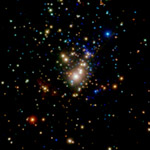 The stars of
Orion shine brightly in visible light in planet Earth's night sky. The constellation
harbors the closest large stellar nursery, the Great Nebula of Orion, a mere 1,500
light-years away. In fact, the apparently bright clump of stars near the center of this
false color Chandra x-ray telescope picture are the massive stars of the Trapezium - the
young star cluster which powers much of the nebula's visible-light glow. The stars shown
in blue and orange are young sun-like stars; prodigious sources of x-rays thought to be
produced in hot stellar coronae and surface flares in a young star's strong magnetic
field. |
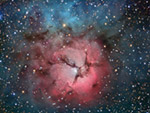 Unspeakable
beauty and unimaginable bedlam can be found together in the Trifid Nebula. Also known as
M20, this photogenic nebula is visible with good binoculars towards the constellation of
Sagittarius. The energetic processes of star formation create not only the colors but the
chaos. The red-glowing gas results from high-energy starlight striking interstellar
hydrogen gas. The dark dust filaments that lace M20 were created in the atmospheres of
cool giant stars and in the debris from supernovae explosions. |
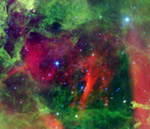 Winds and
radiation from massive hot stars in the Rosette Nebula have cleared the natal gas and dust
from the center of the nearby star-forming region. They also pose a danger to planet
forming disks around young, cooler stars in the neighborhood. This Spitzer Space Telescope
infrared image of dust clouds near the Rosette's central region, shows the cleared-out
cavity. The view spans about 45 light-years at the the nebula's estimated distance of
5,200 light-years. |
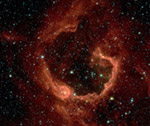 A cosmic
bubble of gas and dust, RCW 79 has grown to about 70 light-years in diameter, blown by the
winds and radiation from hot young stars. Infrared light from the dust embedded in the
nebula is tinted red in this gorgeous false-color view from the Spitzer Space Telescope. A
good 17 thousand light-years away in the grand southern constellation Centaurus, the
expanding nebula itself has triggered star formation as it plows into the gas and dust
surrounding it. |
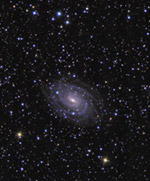 The universe
is filled with galaxies. But to see them astronomers must look out beyond the stars of our
galaxy, the Milky Way. For example, consider this colorful telescopic view of spiral
galaxy NGC 6384, about 80 million light-years away in the direction of the constellation
Ophiuchus. At that distance, NGC 6384 spans an estimated 150,000 light-years. The sharp
image shows details in the distant galaxy's blue spiral arms and yellowish core. Still,
the individual stars seen in the picture are all in the close foreground, well within our
own galaxy. The brighter Milky Way stars show noticeable crosses, or diffraction spikes,
caused by the telescope itself. |
 Sometimes,
after your eyes adapt to the dark, a spectacular sky appears. In this case, a picturesque
lake lies in front of you, beautiful green aurora flap high above you, brilliant stars
shine far in the distance, and, for a brief moment, a bright meteor streaks by. This
digitally fused breathtaking panorama was captured late last month across one of the Chena
Lakes in North Pole, Alaska, USA, and includes the Pleiades open cluster of stars on the
image right. |
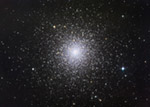 This immense
ball of half a million stars older than the Sun lies over 30,000 light-years away.
Cataloged as M3 (and NGC 5272), it is one of about 150 globular star clusters that roam
the halo of our Milky Way Galaxy. Even in this impressively sharp image, individual stars
are difficult to distinguished in the densely packed core, but colors are apparent for the
bright stars on the cluster's outskirts. M3's many cool "red" giant stars take
on a yellowish cast, while hotter giants and pulsating variable stars look light blue. |
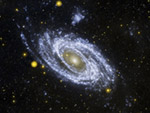 Where are the
hot stars in M81, one of the closest major spiral galaxies? To help find out, astronomers
took a deep image in ultraviolet light of the sprawling spiral with the Earth-orbiting
Galex telescope. Hot stars emit more ultraviolet than cool stars, and are frequently
associated with young open clusters of stars and energetic star forming regions.
Magnificent spiral galaxy M81, slightly smaller in size to our own Milky Way Galaxy, shows
off its young stars in its winding spiral arms in the above image. Less than 100 million
years old, the young stars are blue in the above false-color Galex image and seen to be
well separated from the older yellowish stars of the galactic core. |
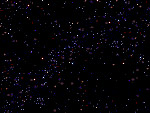 Here is a good
image of a starry night that you can use as a background on your computer or on your
website. |